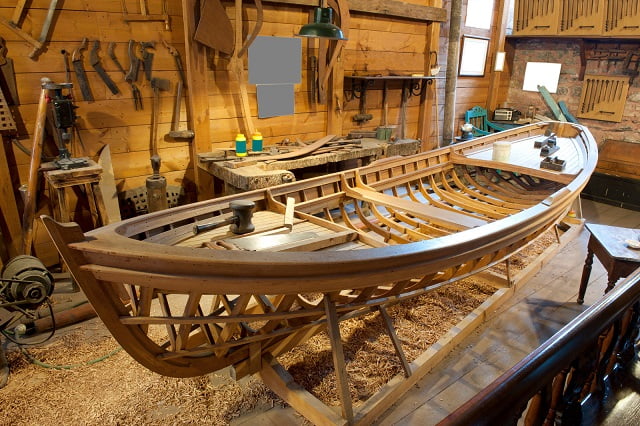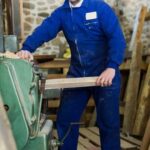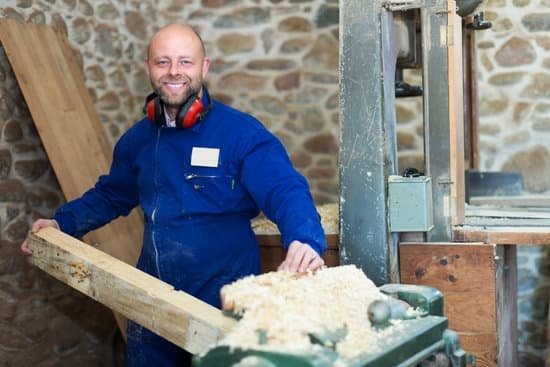
Woodworking for boat building requires an understanding of both the principles and practical applications of this traditional craft. It is a form of carpentry, which uses specific tools, techniques, supplies, and materials to construct a watercraft. Many traditional wood designs are still used today in the construction of vessels for sailing, fishing, and recreational boating purposes.
An aspiring boat builder will need to learn the fundamentals of joinery methods as well as how to work with various types of wood such as oak, mahogany or spruce. Additionally they will need to understand the principles behind keel design, frames structures, deck sealing and caulking techniques. All these factors come together in creating a unique woodworking experience that culminates in a finished sea worthy vessel that is sure to turn heads wherever it sets sail.
Oftentimes in the world of boat building joinery can make or break your project in regards to quality and durability for many projects including necessary components like decking systems and internal frame support structure. Joinery is simply any mechanical method employed when fastening two separate pieces of timber together including dovetail joints, mortise-and-tenon joints and finger joints just to name a few.
Each joint type comes with its own set challenges depending on the application and environment it will be used in.
For example, some joinery might be better suited for constructing cabins known as bulkheads due to the need for stronger connections while others might be suitable only for general structural tasks. Learning how to create efficient yet strong joints between pieces is essential before one begins their venture into constructing bigger boats from scratch.
Woodwork involves supremely accurate measurement taking – each part must fit precisely so make sure you have purchased an appropriate set of tools for measuring lengths accurately – tape measures are generally acceptable but carpenter’s rulers may also prove useful at times depending on what type of project you plan on taking up. Adhesives too play an important part here – buy modern resins like epoxy resin over paste ones which usually last longer even if they cost more money initially.
Power tools are also widely used when one needs mass production timeframes or detailed cuts for more complex shapes; remember though that they require good maintenance or else suffer significant dropoffs in performance. Other specialty items like chisels, manual saws; clamps etc do exist but only purchase them after prior research has been performed since you don’t want any surprises during construction time.
Woodworking for boat building can be both rewarding and daunting when taken seriously as per all other similar hobbies today – it is essential to perform good amounts of research first regarding available materials & equipment before spending hard earned money otherwise serious repair bills may follow shortly after completion down the road somewhere.
Nonetheless once proper preparation & planning are put into place, hours spent working are almost certainly guaranteed high levels reward both spiritually & economically over time making it worthwhile if taken seriously enough by enthusiasts worldwide.
History & Origin of Woodworking For Boat Building
Woodworking for boat building has been around since the Bronze Age. Early ships used wood for the hull, as well as for sails and masts. Over time, woodworking techniques have become more sophisticated, allowing boats to be built that are lightweight and yet strong enough to withstand the tough conditions of open waters. Traditional boat-building is a craft that is still practiced today in many regions of the world.
Advantages of Woodworking For Boat Building
Woodworking has several advantages when building boats:
- It is relatively inexpensive compared to other building materials.
- It is easy and fast to work with.
- Wood can flex when needed to bear heavy loads.
- Modern construction methods such as epoxy gluing can make wood stronger than ever before.
- The aesthetic appeal of a wooden boat cannot be denied.
Composition & Types Of Wood Used In Boat Building
There are several types of wood used in boatbuilding, both hardwoods and softwoods have their benefits. Hardwoods such as mahogany and teak are often preferred for their strength and durability but also come with a higher price tag.
Softwoods such as cedar, fir, spruce, pine, cypress and redwood on the other hand offer an excellent alternative due to their availability at cheaper prices while still offering good strength and stability. Plywood panels made from various types of wood can also be used in boatbuilding to provide extra stiffness to a structure while remaining light weight.
Types of Tools & Materials Used in Woodworking For Boat Building
Woodworking for boat building involves many different tools and materials. Without the right tools and materials a boat builder would struggle to create the craft they desire. The following is a list of tools and materials commonly used in woodworking for boat building:
- Hand Tools – Hand tools such as saws, chisels, carving knives, hammers, planes, measuring tape and squares are essential for making precise cuts and assembling parts.
- Power Tools – Power tools like drill presses, sanders, routers and jointers can make quick work of large quantities of material.
- Adhesives & Fasteners – Adhesives such as epoxy glue and polyurethane adhesive help to bond two pieces of wood together while fasteners like nails or screws are ideal for attaching metal components to wooden construction.
- Clamps & Vises – Clamps are necessary for holding pieces of wood together securely while vices do the same job when timber needs to be cut accurately.
- Types of Wood – Different types of woods can be used depending on the project. Hardwoods such as oak, ash or mahogany might be used in areas where strength is important whereas softwoods like pine or cedar might be employed for flexibility.
- Finishing Materials – Once the construction is complete boats must often undergo painting or staining to protect them from damage. Other finishing materials include varnishes, sealants sandpaper etc.
The selection of appropriate tools and materials will depend on the type of project being undertaken. For example some projects may require specialised items like bamboo fibre mesh cloths which reinforce lightweight fibreglass composite construction techniques. On the other hand projects involving traditional methods may have more need for carpentry tools such as spokeshaves or drawknives.
When cutting and shaping timber various types of saws can come into play including ripsaws, crosscut saws and backsaws. It is important that blades are suitable for the task in hand as an unsharpened poorly maintained blade can cause serious problems leading to poor quality workmanship.
In terms of materials plywood has become popular lately due its favourable strength-weight ratio but other options exist too such as marine grade plywood which has exceptional resistance to moisture damage. And then there are sawn timbers which are generally preferred over plywood when more complex 3-dimensional boat designs are called into motion since they allow greater freedom when bending or moulding shapes.
Different Techniques of Woodworking For Boat Building
Woodworking craftsmen have been using the same techniques for centuries to build boats that can withstand the toughest of oceanic conditions. The first step when woodworking for boat building is to decide what type of boat will be built and gather suitable wood for the job. Teak, cedar or mahogany are all popular options due to their strength, durability and resistance to rot.
Once the right kind of wood is identified, it needs to be cut into planks that are the correct size and shape as per the plans. It’s essential that each plank is identical in size so that it fits snugly against its neighbor when assembling the vessel. This technique is called ‘scarfing’ and involves joining two pieces of wood together with a special wedge (called a scarf joint) at an angle, reinforcing it with screws and glue.
Having established a strong framework, batten seam strips are then used to ensure all planking gaps match up evenly on either side. This process entails bonding lengths of timber along each plank joint before covering them in epoxy resin or marine-grade sealant for protection against moisture damage. To attach these strips more securely, stainless steel nails are generally used rather than galvanized due to corrosion concerns.
Different types of woodworking equipment must be used when constructing boats on this scale:
- Power tool – drill, jigsaw.
- Hand tools – saws, sanders.
- Carpentry tools – chisels, rulers.
- Measuring devices – protractor & square.
- Marking devices – compass & crayon.
To finish off any wooden boat building project successfully requires abrasives and sealants such as sandpaper, paint or varnish which stops water entering through pores in the wood fibres. Finally, screws and bolts should also be added to secure hull components firmly together – brass or stainless steel varieties work best here too due to corrosion risks associated with traditional iron bolts/metal fasteners.
Step-by-step Guide on Building a Boat With Woodworking
Woodworking is a craft that dates back to antiquity and is still practiced today. In recent years, many people have learned the skill of woodworking to build boats from scratch with plans from maritime supply outlets or getting creative on their own. Building a boat can be both an enjoyable and rewarding hobby for the DIY lover, and if done properly and with safety in mind, it can also be a safe experience that produces beautiful results.
No matter what type of woodworking project someone may choose, there are basic steps that will remain universal throughout the process:
- Gather materials – Choose quality wood such as mahogany marine-grade plywood, Okoume marine-grade plywood or spruce fir. Depending on your project, you may need additional items like epoxy resins.
- Design – Before building, make sure to either draw up plans or design the pieces you’ll need on computer software.
- Cut the parts – Make exacting cuts using saws like table saws or jigsaws.
- Sand down – Smooth out all surfaces with sandpaper to ensure no rough edges remain.
- Glue & laminate – Lamination gives strength to larger projects by adhering layers together, while epoxy glue helps small parts attach together.
- Install hardware and fittings – Use certain hardware like bolts and washers for structural support; fittings are used for aesthetic purposes.
- Finish – Use oil-based varnish or polyester resin, fibreglass cloth and resin mixture to seal and protect your boat while simultaneously giving it shine.
Once these steps have been completed, a bespoke wooden boat will be ready for use. Construction times will vary depending on size of the boat which is being made but typically it takes several weeks from start to finish.
Woodworking skills play an important part when building any boat because precise cuts must be made in order for everything from bulkhead reinforcements to mast steps fit seamlessly each time they are installed. Many tools such as hand planes, drill bits and router bits can all contribute significantly during this stage of construction; patience is key in ensuring that every component is assembled with great attention to detail so that nothing moves under pressure once tested out in the waters.
Benefits & Drawbacks of Using Woodworking For Boat Building
Woodworking is one of the oldest and most utilized methods for boat building. There are several benefits to using woodworking techniques when constructing a boat, however there are some drawbacks that come along with it as well.
One of the main benefits of using woodworking for boat building is its aesthetic appeal. Wood gives a natural beautiful look to your finished vessel which has been seen for hundreds of years throughout various maritime cultures around the world.
Not only does the final product look great, but working with wood also makes the boatbuilding process more enjoyable and rewarding. With the right skills and tools, you’ll be able to create something unique that’s tailored directly to your needs and preferences.
Another benefit comes from either using existing wooden pieces or buying planks to create parts of your vessel such as masts, sails, hulls etc. This allows you to decide exactly how each piece should look like in terms of size, shape and appearance while giving you full control over every step during construction process. It also enables boats builders to customise their projects while making sure that they meet professional standards.
Despite these advantages, there are some drawbacks associated with woodworking in terms of boatbuilding. One drawback is related to cost; Wooden pieces used for starters will be more expensive than buying pre-manufactured materials like aluminium or fiberglass due its limited supply on the market but also much time needed for cutting, shaping and assembling all parts accurately by hand in order to have ready functioning vessel in end.
Another issue comes from maintenance since wooden boats require more care if compared with those made from other materials like fibre glass because they can’t brave rough watery conditions underwater for too long.Therefore,an additional cost might be having upkeep work done regularly so exposed parts do not rot or develop other problems that could compromise safety onboard.
Overall, it’s usually worth investing both money and time into creating a boat out of wood since this tends to deliver satisfactory results both aesthetically as well as functionally when done correctly. Whether you’re looking for an old fashioned kind of beauty or merely trying go back in maritime history it certainly makes sense look into traditional ways choose boats construction like what woodworking offers us today.
Safety Tips for Woodworking For Boat Building
Woodworking for boat building can be an enjoyable and rewarding experience, but proper safety measures must be taken to ensure the safety of all individuals involved. When it comes to this type of woodworking, the key is to take things slow and be aware of any potential hazards. Here are some specific safety tips for woodworking for boat building:
- Wear Protective Gear: Any time you are working with power tools or sawing out pieces of wood, it’s important that you wear protective gear to protect your eyes and hands from injury. Goggles should also be worn since wood chips and splinters have a tendency to fly off when power tools are in use.
- Organize Your Working Area: Organization is key when it comes to woodworking projects especially ones as complicated as boat building. Having everything organized will not only help you to work more efficiently but will also help reduce accidents caused by confusion.
- Be Careful With Sharp Tools: Always handle knives and saw blades with care, as they can cause serious injury if misused. Make sure you use them correctly and never try to force them through materials.
- Always Practice Good Measurements: Measuring twice before cutting isn’t just something they say; it’s necessary for ensuring accuracy while working on boats. Always take extra measure when marking out lines or measuring surfaces.
- Clean Up Aftewards & Take Breaks: Clean up your workspace after every session so that the materials won’t get damaged over time due to dirt or dust build-up. And don’t forget to give yourself breaks; especially if you become tired or start feeling stressed out.
In addition to these specific tips, there are some general rules that should always be followed when performing any kind of woodworking project – whether for a boat or otherwise. Wear protective clothing, stay alert at all times and make sure that there is someone nearby who can come in case emergency assistance is needed.
Furthermore, always keep carbon monoxide monitors running around the house whenever operating power tools indoors; carbon monoxide gas can quickly build up in enclosed spaces such as garages – potentially leading to death if it goes unnoticed for too long.
Additionally, always check electrical cords periodically for signs of fraying or exposed wires; these can cause electric shock if touched unexpectedly while in use. Finally, always read all material safety data sheets carefully before using any chemicals or materials involved with the boat building process – this way you will understand precisely what precautions should be taken before handling those substances near heat sources.
Must-have Products for Woodworking For Boat Building
Woodworking for boat building has been a popular hobby for many since ancient times and continues to be popular today as well. The materials, tools, knowledge, skills, and creativity involved in the process make it an immense pleasure for the woodworker. But in order to properly undertake this type of project there are some must-have products that are essential for success.
Wood
The most important material needed in boat building is wood. Marine grade stock such as mahogany, teak, cedar, or ipé will provide the best results as these all possess great strength combined with good decay resistance.
Many other kinds of wood can also be used although durability won’t be as reliable and a protective sealant should be applied regularly. These woods can often be found at local lumber yards but specialty shops may need to be visited if more unusual species are desired.
Aquarium Grade Resins
Resin is used to waterproof non-wooden components in wooden boats such as hulls and decks. Aquarium grade epoxy resin systems available from boatbuilding stores can ensure watertight compartments and integrity are maintained over time reducing the potential for damage during spills and other accidents on board vessels.
Polyester resins consist of two parts – a catalyst and a resin hardener so should only be used if their proper combination is achieved; if not following manufacturer’s instructions can result in less than desirable outcomes.
Fillers
Another important product required is fillers which are used to shape planks or components before they form part of the hull or deck structure making it easier for them to fit into place offering greater accuracy when building on larger vessels such as boats which require tight curves at its edges.
Fillers also help reduce air bubbles while allowing adhesives to flow more evenly into separations between sections thus providing strength over time even when exposed to water or moisture frequently found around recreational boats.
This will protect against rot while reducing repair requirements down the road making them invaluable when constructing secondhand vessels that may not have had regular maintenance previously completed on them.
Common Mistakes to Avoid When Woodworking for Boat Building
When it comes to boat building, woodworking may be a daunting and challenging field to venture into. There are many components that will need to be considered when you’re constructing your vessel such as materials, design and safety.
Not having the right resources or skill is often where mistakes are made and can prove costly for your project. Therefore, it’s important to understand certain basic concepts when it comes to woodworking for boat building so some of these common mistakes are avoided.
A key mistake that is frequently committed in woodworking for boat building is not having the right materials. It’s important to learn which type of woods are best suited for which areas on the boat.
For instance, hardwoods like mahogany or teak would be used on larger surfaces such as hulls while lighter woods would do better inside cabin walls and doors due to weight issues. Additionally, extra consideration should also be taken when it comes to selecting protective coatings like paint that won’t deteriorate in salt water environments or other harsh conditions.
Another big mistake made during woodworking fo rboat building is focusing too much on aesthetics instead of construction details. Oftentimes individuals want their vessels to look aesthetically pleasing but they don’t always invest time into researching the technical aspects of construction that allow boats actually stay together structurally and remain seaworthy over long periods of time. A good balance between aesthetics and proper construction techniques must be taken if you want long lasting results from your wooden boat structure.
Lastly, one essential mistake that must be avoided is not recognizing potential safety issues related to your vessel’s structure before launching your new boats out into sea or any body of water.
Doing so can result in serious harm or even worse should an unforeseen issue emerge while in use such as rot, splintering or corrosion in a beam support etc Ensuring structural components are properly designed from scratch with quality craftsmanship up until its launch date can prevent serious dangers from occurring during use and should not be overlooked especially when working with wood crafts.
Summary & Conclusion
Woodworking is an essential part of boat building. It involves many skills and techniques including carpentry, joinery, metal-working and upholstery. In addition to creating the shell of the boat itself, woodworking also contributes to a completed interior with furniture pieces, window treatments and other intricate details.
The actual process of building a boat utilizing woodworking requires noticeable attention to detail. It starts by constructing the main hull of the watercraft followed by its decking and cabin structures.
This can be done in a number of different ways, each offering their own unique characteristics regarding strength and flexibility while accommodating different methods such as riveting or epoxy bonding. Once the shell is complete it is then necessary to move on to the internal components like framing, seating areas and storage compartments which are somewhat easier yet still demand close attention with respect to joining techniques and finish work.
Finally once all of these elements are crafted together it is time for sanding down the rough areas followed by varnishing which coats wood surfaces with oils or polyurethane mixtures providing visibly pleasing look as well as long-lasting protection from external elements such as water or wind damage over time.
All in all, woodworking has been used traditionally in boat building since antiquity until modern times; given its versatility there’s no surprise why it continues to remain relevant even today when there’s a vast array of materials available for use in the same context.




